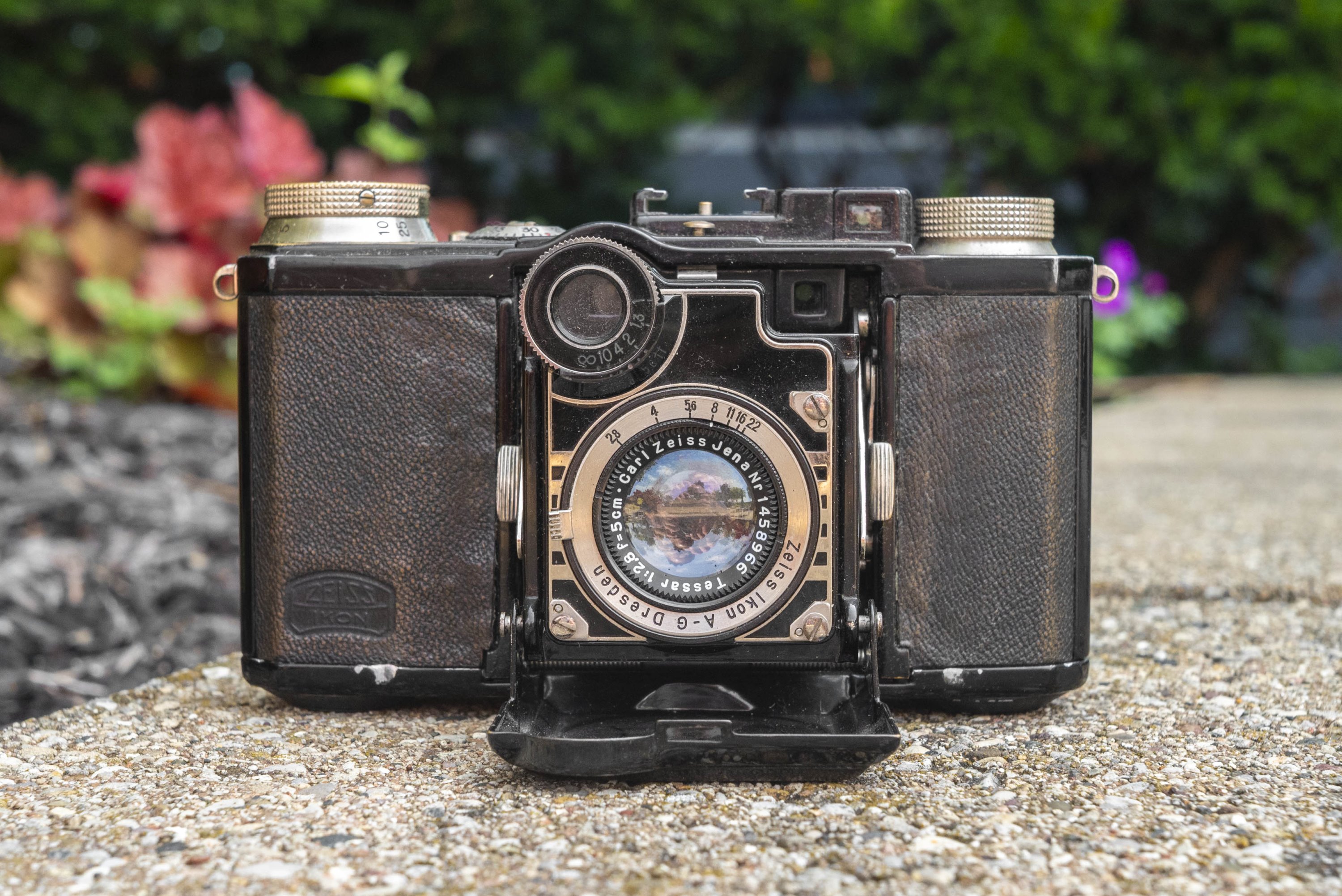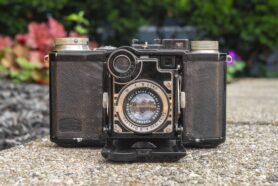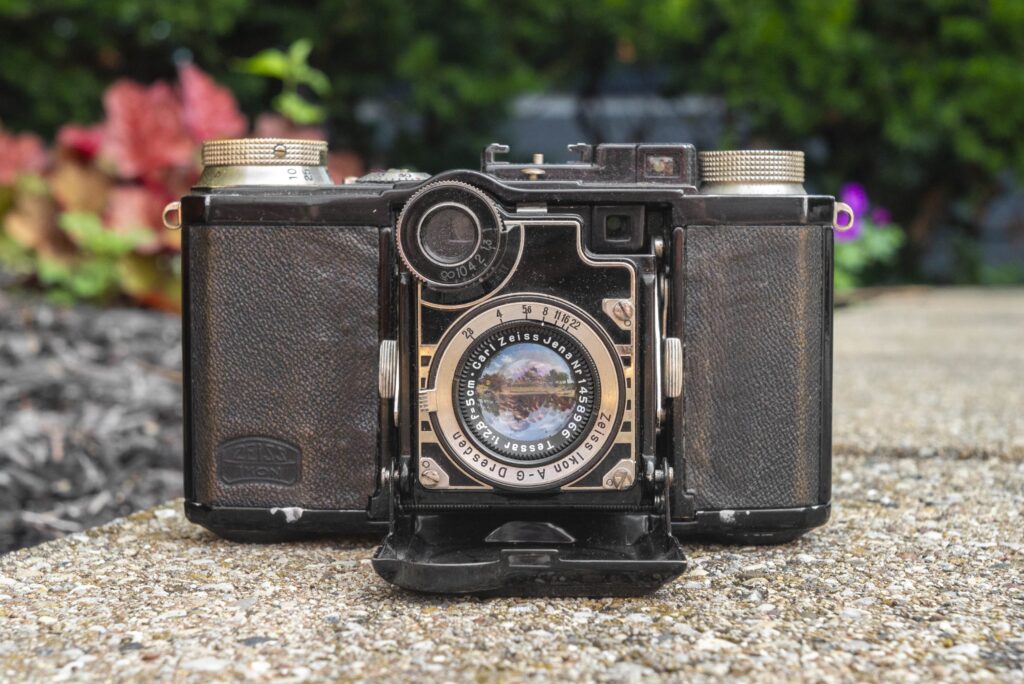This is a Zeiss-Ikon Super Nettel, a 35mm rangefinder camera made by Zeiss-Ikon AG Dresden between the years 1934 and 1936. It was built to be a more affordable alternative to the more expensive Contax rangefinder which was introduced in 1932. The Super Nettel shares a similar vertically traveling focal plane shutter, and rangefinder arrangement, but has a non removable lens and a folding bellows type body. Although not as expensive as the Contax, this was not an inexpensive camera and only sold in small numbers. A revised version called the Super Nettel II would be released in 1936 with a chrome body. That same year, a rigid body version of the camera was sold under the name Nettax.
Film Type: 135 (35mm)
Lens: 5cm f/2.8 Carl Zeiss Jena Tessar uncoated 4-elements in 3-groups
Focus: 0.9 meters to Infinity
Viewfinder: Separate Viewfinder and Coincident Image Coupled Rangefinder
Shutter: Vertically Traveling Metal Focal Plane
Speeds: B, 1/5 – 1/1000 seconds
Exposure Meter: None
Battery: None
Flash Mount: None
Weight: 634 grams
Manual: https://www.cameramanuals.org/zeiss_ikon/zeiss_ikon_super_nettel.pdf
In 1925 when Ernst Leitz released the first Leica camera, the world was put on notice that a shift was coming in the preferences for the photographic community. By the start of the 1930s, double perforated 35mm “kine” film was the fastest growing film type. A large number of German camera makers scrambled to get their own 35mm film cameras to market.
In 1932, Zeiss-Ikon would release the Contax rangefinder camera, which was their response to the Leica. Where the Leica was simple, yet elegantly designed with an interchangeable threaded lens mount, and an optional rangefinder model available, the Zeiss-Ikon Contax was a technological tour-de-force with a long list of features, a whole system of the world’s best lenses, and a level of complexity far exceeding that of the Leica.
While the Contax was a monumental camera, it was extremely expensive. In the 1934 Central Camera catalog, the Contax body sold for $106.50 without a lens. Option it with a modest f/2.8 collapsible Carl Zeiss Jena Tessar 5cm f/2.8 and the price grew to $168. With the top of the line Carl Zeiss Jena Sonnar 5cm f/1.5 lens, the camera topped out at $299. When adjusted for inflation, these prices compare to about $2550, $4000, and an astounding $7150 today!
With prices out of reach for all but the wealthiest photographers, the Contax wasn’t an option for most people. In an effort to get a 35mm Zeiss-Ikon camera into the hands of more photographers, the decision was made to come up with a more affordable camera with a scaled down feature set.
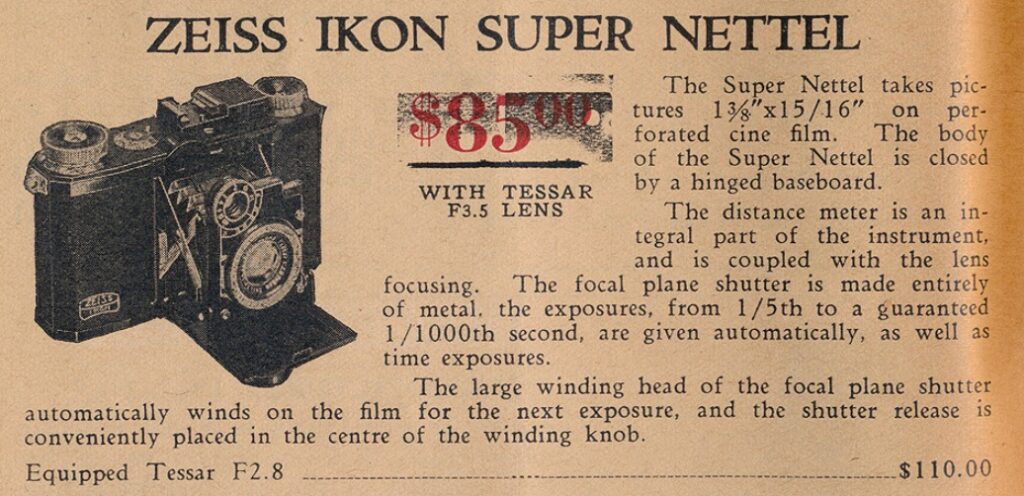
In 1934, Zeiss-Ikon would release their scaled down Contax which they called the Super Nettel (536/24). Borrowing the name “Nettel” from the company’s medium format folders, the Super Nettel was a folding 35mm camera. It came with a coupled rangefinder, a focal plane shutter, and a fixed Carl Zeiss Tessar lens. The shutter was a vertically traveling design that was very similar to the Contaxes, but not exactly. The biggest difference was a lack of speeds below 1/5. Three lenses were available for the Super Nettel, two 5cm Tessars, one with a maximum aperture of f/2.8 and the other f/3.5, and the third being a Zeiss Triotar f/3.5. Prices for the two Super Nettels were $110 and $85 respectively, which when adjusted for inflation, compare to $2625 and $2025. I could not find any prices in any US publications for the Triotar version.

In 1936, two years after the Super Nettel’s release came a model called the Super Nettel II (537/24) which was essentially the same camera, except with a chrome body, instead of a black enamel finish. The Super Nettel II was only available with the 5cm f/2.8 Tessar, unlike the first model which had two other options. According to some sources online, this model is called a Special Edition, however I found no contemporary evidence from around the time it was released suggesting that Zeiss-Ikon presented it this way. A more accurate description of the Super Nettel II was perhaps it was a last ditch effort to sell off inventory as later in the same year, a new camera called the Zeiss-Ikon Nettax was released.

The Nettax, despite having a completely different name, was seen as the successor to the Super Nettel, even having a very similar catalog number of 538/24. The Nettax ditched the folding body of the Super Nettel, replacing it with a collapsible lens with no bellows. It had a similar circular wedge rangefinder and the same shutter, however one additional trick was that its lens could be swapped out for an optional Carl Zeiss Jena 10.5cm f/5.6 Triotar telephoto lens. Catalog prices for the Nettax from 1936 were $165 for the camera with the 5cm f/2.8 Tessar, and an additional $120 for the 10.5 telephoto lens.

While quite a bit cheaper than the Contax, the Super Nettel and Nettax did not sell as well and few were ever made, making these cameras difficult to find today. I could not find any contemporary reviews of the camera from the era in which it was released to get a sense of what people thought about it. If I had to guess, the biggest struggle would have been that despite a lower than Contax price tag, the Super Nettel was still very expensive, and cheaper options like the Kodak Retina, Certo Dollina, and Welta Weltini were also available with the same lenses, and nearly identical feature sets.
I picked up the Zeiss-Ikon Super Nettel shortly after getting my original Contax I CLAd by Radu Lesaru and I found it to be an interesting comparison. The Super Nettel was in very good condition, however I don’t believe it had been serviced recently. Still, it compared favorably in terms of smoothness with the Contax. The rangefinder was accurate and the shutter fired at all speeds. As with every Zeiss-Ikon camera I’ve handled, the build quality was exquisite. This example was in extremely good condition with only minimal signs of wear to the black enamel and the entirety of the body covering showing very little signs of use. The f/2.8 Tessar lens was haze free and only showed minimal signs of scratches. It was clear, this camera was barely used throughout its life and as best as I can tell, is in as good of operating condition as you can expect.

The Super Nettel was sold as a less expensive folding version of the Contax, and quite frankly, you could stop there and know everything you’d need to know for this review. I’ve you’ve handled an original Contax I, there are a lot of similarities from the design of the combined film advance and shutter speed knob. Changing shutter speeds requires lifting up on the knob and rotating it until your chosen speed from 1/5 to 1/1000 lines up with a dot, and then you let it drop down into position. The film back is almost exactly the same as is the film loading process. The Super Nettel supports the same Contax-style reloadable or preloaded 35mm cassettes. Although the design of the rangefinder is different, it works exactly the same way in which the viewfinder and combined image rangefinder are in separate windows. The Zeiss Tessar 5cm f/2.8 is not interchangeable but is optically identical to the same 5cm f/2.8 lens in Contax mount, and both cameras are capable of the same high quality images.
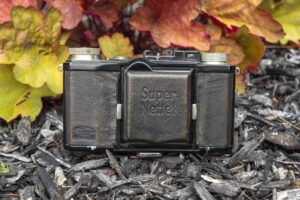
The two differ most significantly in that one is a folding camera and one is not. From the front, the two cameras look very different. Opening the front requires you to press down on a small latch immediately forward of the accessory shoe. Closing the camera requires you to press in on two metal tabs to the left and right of the opening while folding the door shut. With the lens fully erected, the rotating wedge of the rangefinder is above and to the right of the lens. The lens diaphragm is controlled by a small lever to the left of the lens. On this model, f/stops from f/2.8 to f/22 can be chosen.

Focus is controlled by a knurled wheel surrounding the rangefinder window. Distance markings are in meters and there is a very small and difficult to see depth of field scale below the rangefinder window. This location is comfortably located and mimics the top plate focus wheel on the Contax. Unlike the Contax however where you don’t need to use the top plate wheel and can focus the lens directly, on the Super Nettel, you have to use this wheel and I found it to be a bit slower in operation than simply twisting the lens directly.
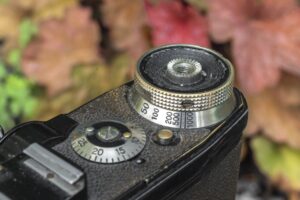
The Super Nettel made its debut in 1934, midway through production of the Contax I, yet it doesn’t share that camera’s front face shutter speed dial. Instead, it has a top plate shutter speed dial with combined shutter release which wouldn’t appear on a Contax until 1936 with the release of the Contax II. This is interesting because it suggests that either some aspects of the Contax II’s design were already thought of in 1934, or perhaps when the Contax II was in development, they shared parts with the Super Nettel. Changing speeds is done by lifting up and rotating the dial until a dot on the dial lines up with engraved shutter speeds from 1/5 to 1/1000.
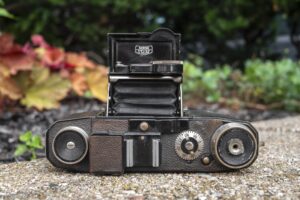
Other controls on the top plate are the large rewind knob which has a strong knurled pattern on the outer edge for easy grip, an accessory shoe which allows use of many accessories available for the camera, the additive exposure counter, a small rewind release button, and finally the combined shutter speed dial with cable threaded shutter release in the center. One surprising thing about the Super Nettel is that with the shutter cocked, you can still fire the shutter with the camera folded shut. It is surprising to me that Zeiss-Ikon didn’t design some kind of interlock to prevent accidental exposures with the camera shut. I read the Super Nettel manual and it makes no reference to this, so I am uncertain if my camera is malfunctioning, or if it simply doesn’t have an interlock.
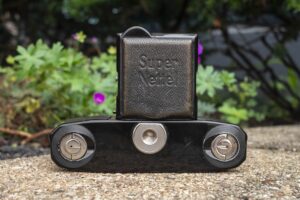
The base of the camera has a raised 3/8″ tripod socket in the center. If you wish to use a modern tripod, a 1/4″ adapter would need to be used. On either side of the camera are two rotating locks for opening the film compartment. Like with the Contax, fold each lock out and rotate them to unlock the back of the camera.

With the back off, the film compartment is where the Super Nettel most closely resembles the Contax. While the Super Nettel does not have the same range of shutter speeds, the shutter curtains look exactly the same. The familiar vertically traveling metal focal plane shutter is here, along with a supply side on the left and take up on the right. Like the Contax, the Super Nettel supports spool to spool transfer and it can use the metal Contax reloadable spools. Kodak’s later type 135 daylight loading spools may be used too, although there is a chance that film alignment will be off by about a millimeter. Inside the door is a flat metal pressure plate.
An interesting accessory that was available for both the Contax and Super Nettel is a plate film holder that replaces the entire back of the camera. This accessory was designed for those situations where only a single exposure is desired. A side effect of using a plate film adapter on a 35mm film is that the film plane is farther back than normal which increases the image size. Instead of producing a 24mm x 36mm image, with the plate film adapter, the image increases in size by 56% to 30mm x 45mm. In addition, since the focal plane is not the same, the Super Nettel’s built in rangefinder cannot be used for focusing. Instead, a piece of ground glass is inserted into the plate holder to measure precise focus, then is swapped out for the film holder at which point the exposure can be made.
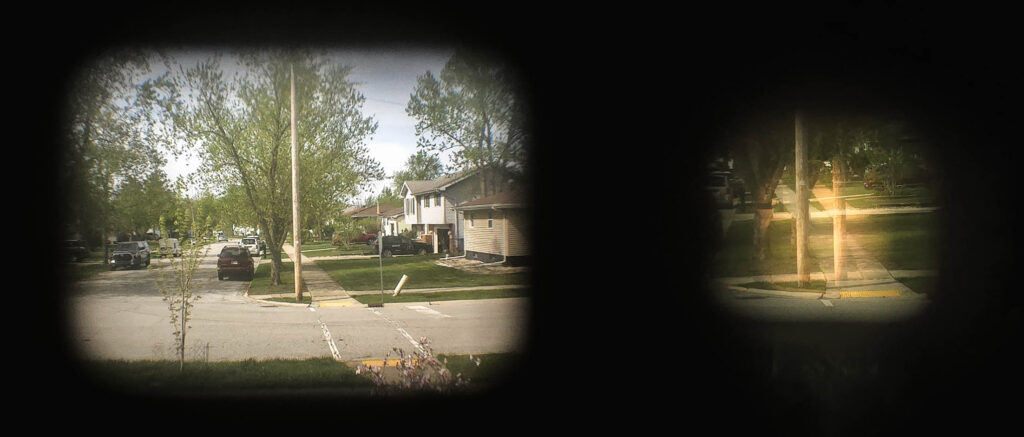
The Super Nettel has separate rangefinder and viewfinder windows. The viewfinder has a smaller magnification which makes images smaller than they appear but has the benefit of making the entire framed image easier to see. With prescription glasses, I can almost see all four corners. The rangefinder window is to the right of the viewfinder and since it depends on the rotating wedge mounted to the shutter, the rangefinder cannot be used with the camera folded shut. Opening the camera allows you to see through the rangefinder, which is a coincident image design. The square rangefinder has a strong yellow tint and makes up almost the entire visible window of the rangefinder. The rangefinder also has an increased magnification which makes precise focus very easy. Further enhancing the rangefinder is good contrast from the two windows. I found the rangefinder on the Super Nettel to be one of the best I’ve used on a camera from this era.
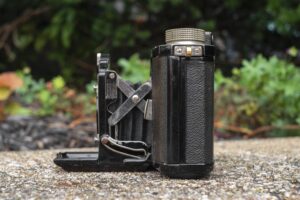
Back when this camera was sold new, it was marketed as a “folding Contax” and while there are enough differences beyond the folding design where I wouldn’t quite agree with that assessment, I’d say that the cost savings make the Super Nettel like a more affordable alternative to the Contax. If you could limit yourself to only a single focal length, and appreciated a more compact and portable camera, the few compromises of the camera are well worth it.
Like Zeiss-Ikon’s other cameras of the era, the build quality is exceptionally high, and each of the camera’s controls are easy to use and thoughtfully laid out. Unlike Leica rangefinders of the same era, no parts of the camera rotate while the shutter is firing, eliminating chances that a stray finger could interfere with the supper operation. In addition to an excellent f/2.8 Tessar lens, the list of accessories more than make up for the lack of interchangeable lenses. With my initial praise out of the way, it is time to load in some film and take it out shooting!
For the first roll in the Super Nettel, I chose a roll of expired Kodak TMax 100 I had gotten in a lot of expired film. While I often shoot bulk TMax, I rarely use the retail cassettes, so I was eager to see the results from this roll.
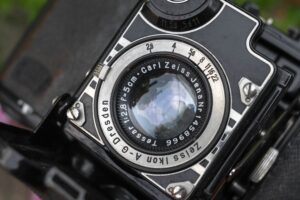
Before I can comment on the quality of images I got from my first roll, the 4000 pound gorilla is the obvious mold that existed on the film when I shot it. Not really knowing the age or the condition of the expired roll of Kodak TMax 100, I assumed I’d have the same luck with this roll as I do with the many bulk rolls of TMax I have. Sadly, it would appear that this particular roll aged poorly and developed the finger-like tendrils on every image. Despite this, the emulsion still did what it was supposed to, and I got a roll of mostly properly exposed images with good contrast and sharpness. In a weird sort of way, I kind of like the distressed look that the fungus gave this film, but its not something I’ll easily be able to recreate. If I ever do shoot a fresh roll of film in the Super Nettel, I’ll be sure to update this gallery with updated pics.
Looking past the degraded film, it is clear that the f/2.8 uncoated Zeiss Tessar still delivers the goods. The images show signs of incredible sharpness and detail. I didn’t notice any obvious vignetting, however parts of the top edge of several images were a bit darker than the rest, suggesting perhaps the shutter is showing early signs of failure. The Super Nettel, having a vertically traveling shutter, if the speeds are off, you’d see uneven exposure near the top or bottom of the frame, which is what I am thinking is happening here. But the lens, the lens hit it out of the park. If Zeiss-Ikon marketed this camera as a lower cost folding Contax, I can clearly see that the quality of the 5cm lens is definitely on par with anything you could expect from the much more expensive Contax.
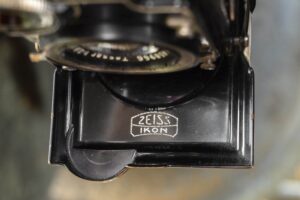
Using the Super Nettel was a very satisfying experience. The ergonomics of this camera don’t lend it to be compared to the Contax as there are more differences than similarities, so the best comparison I can make would be to a Kodak Retina. One thing that the Super Nettel does better than any Retina is that it has a down folding door. This means that the lens and shutter can be accessed from either side of the camera, unlike the Retina whose door blocks one whole side to the camera. I much prefer down folding doors such as those like the Certo Dollina.
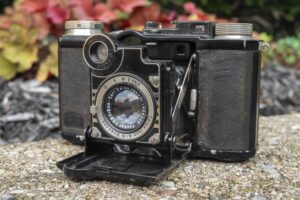
The location of the focusing wheel around the rangefinder window was very pleasant and easy to use. While I won’t say any Retinas are difficult to focus, I find that it is more difficult to develop the muscle memory with a Retina to get your fingers to naturally find the focusing tabs, whereas the wheel on the Super Nettel is easy to access with your right index finger without spending any time thinking about it. In addition, the design of the focusing system on the Super Nettel does not require you to set the lens back to infinity before folding the camera shut like the Retina does. You can open and close the camera at any distance and it will return to that when you reopen it.
I had no issue with the viewfinder, despite it being quite small. The size of the rangefinder patch on the magnified rangefinder window made focusing very easy. I’ve spoken before about my preference for cameras with separate viewfinder and rangefinder windows, and the Super Nettel is as good of an example as any.
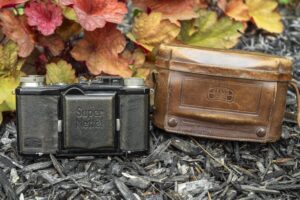
If I had one nitpick about the camera, is that the aperture selector is still quite tiny and fumbly to locate. To be fair, most Compur and Prontor leaf shutter based cameras have tiny aperture controls which are fiddly to access, so I suppose the Super Nettel isn’t any worse than those cameras, but it doesn’t really improve on it either.
Beyond that though, the Zeiss-Ikon Super Nettel is a fantastic camera and one that is very easy and intuitive to use. While I have praised the Contax I for its ease of use and performance, I will admit, that first time users of that camera should still familiarize themselves with the manual, whereas the Super Nettel feels familiar, even if you’ve never handled one. Every aspect of the camera is straightforward and easy to use. That it has a lens which is capable of “pro-level” results, this camera is definitely a winner. If I was a camera reviewer in the mid 1930s and wanted to give buyer recommendations between the Contax and Super Nettel, I would acknowledge that with its interchangeable lenses, the Contax may be a more flexible camera, but for those who primarily shoot 50mm, the cost savings of the Super Nettel make it a far better buy. I realize these cameras aren’t common today and even harder to find in good working condition. Like the Contax, it will be very difficult to find someone willing to give a service to one of these cameras, but if by chance, you ever have a chance to pick one up in good working condition, I wholeheartedly recommend it. I might even go as far as to say, this is my favorite pre-war Zeiss camera.
Related Posts You Might Enjoy
External Links
http://camera-wiki.org/wiki/Super_Nettel
https://www.pacificrimcamera.com/pp/zisupernettel.htm
https://vintage-photo.nl/extravagant-zeiss-ikon-super-nettel/
https://www.collection-appareils.fr/x/html/page_standard.php?id_appareil=12007 (in French)

